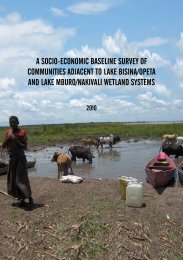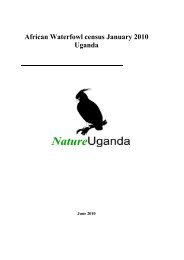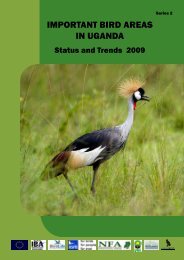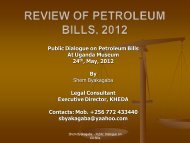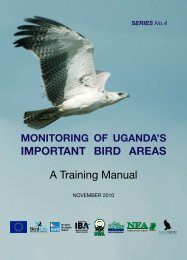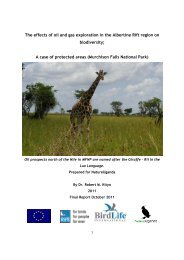the economic valuation of the proposed ... - Nature Uganda
the economic valuation of the proposed ... - Nature Uganda
the economic valuation of the proposed ... - Nature Uganda
You also want an ePaper? Increase the reach of your titles
YUMPU automatically turns print PDFs into web optimized ePapers that Google loves.
Table 7: Projected sugarcane production<br />
Sugar factories<br />
16<br />
Projected Sugarcane production<br />
2003 2004 2005<br />
(tonnes) % (tones) % (tonnes) %<br />
Kakira Sugar Works 980,854 49 1,067,417 46 1,235,955 47<br />
Kinyara Sugar Works 560,406 28 666,217 29 683,813 26<br />
Sugar Corporation <strong>of</strong> <strong>Uganda</strong> Ltd 456,141 23 600,000 26 700,000 27<br />
Total Projection 1,997,401 100 2,333,687 100 2,619,768 100<br />
Adapted from: (USCTA, 2003)<br />
The average sugar recovery ratios are also low. Kinyara<br />
has <strong>the</strong> highest standing at 9.6 percent compared to<br />
Kakira’s 8.9 percent and SCOUL’s 8.4 percent. Following<br />
a crop improvement campaign, Kinyara improved its<br />
cane to sugar ratio to 10 percent in <strong>the</strong> financial year<br />
2004/05. The same campaign helped Kinyara to surpass<br />
its production target <strong>of</strong> 64,000 tonnes <strong>of</strong> sugar per year<br />
by 958 tonnes and to upgrade to a new production<br />
target <strong>of</strong> 93,000 tonnes per year for 2008. Although <strong>the</strong><br />
outgrower contribution also increased to eight hundred<br />
farmers (800), sugar producers remained wary <strong>of</strong> cheap<br />
imported sugar, which makes competition a nightmare.<br />
They also complained <strong>of</strong> a poor road network and argued<br />
that it made <strong>the</strong> expansion <strong>of</strong> <strong>the</strong> outgrower scheme<br />
very difficult. Similar issues were raised at both Kakira<br />
Sugar Works and at <strong>the</strong> Sugar Corporation <strong>of</strong> <strong>Uganda</strong><br />
Limited. Both factories however, suffered production<br />
short falls. The shortfalls were fur<strong>the</strong>r exercebated by<br />
<strong>the</strong> low cane to sugar conversion ratios.<br />
3.4. PERFORMANCE OF UGANDA’S<br />
SUGAR SECTOR<br />
Kakira Sugar Works Limited is <strong>the</strong> largest sugar factory<br />
in <strong>Uganda</strong> in terms <strong>of</strong> yield and output. The company<br />
accounts for forty two (42) percent <strong>of</strong> overall national<br />
output and operates a nucleus estate <strong>of</strong> 12 000 hectares.<br />
The estate benefited from a contentious takeover <strong>of</strong><br />
1,200 hectares that were previously part <strong>of</strong> Butamira<br />
Central Forest Reserve 2 . The company also services up<br />
to 10,000 hectares <strong>of</strong> out-grower contract production.<br />
A systematic expansion <strong>of</strong> <strong>the</strong> SCOUL nucleus plantation<br />
increased cultivable land by thirty three (33) percent<br />
from 9,000 to 12,000 hectares. In October 2006, RAI<br />
Holdings, a Kenyan consortium, paid Ush62 billion<br />
($33.5 million) for a fifty one (51) percent stake in Kinyara<br />
Sugar Works Limited 3 (KSWL) (New Vision Newspaper,<br />
2006). Kinyara Sugar Works factory produces more<br />
than 50,000 tonnes <strong>of</strong> sugar per year from over 500,000<br />
mts <strong>of</strong> sugarcane. The company collaborates with over<br />
800 outgrower farmers operating over 4,600 hectares<br />
<strong>of</strong> cane plantation. Among <strong>the</strong> three sugar factories,<br />
Kakira Sugar Works has <strong>the</strong> largest nucleus estate and<br />
cane output. SCOUL has <strong>the</strong> lowest output (Table 5).<br />
The overall sugar production output from <strong>the</strong> three<br />
factories was 198,000 metric tones. This fell short <strong>of</strong> total<br />
annual demand currently put at 240,000 metric tones by<br />
over 40,000 metric tonnes (East African, 2007).<br />
2 The land use in Butamira CFR changed to permanent<br />
agriculture. The move triggered a law suit by a civil society group. While<br />
<strong>the</strong> group won <strong>the</strong> case, it would appear this was a pyrrhic victory.<br />
3 10 % <strong>of</strong> <strong>the</strong> shares in Kinyara Sugar Works were <strong>of</strong>fer to <strong>the</strong><br />
out-growers <strong>of</strong> Kinyara Sugar Works, ano<strong>the</strong>r 10 % to <strong>the</strong> Bunyoro Kitara<br />
Kingdom and 30 percnet <strong>of</strong> <strong>the</strong> shares are to be traded to <strong>the</strong> public on <strong>the</strong><br />
Kampala Stock Exchange<br />
The Economic Valuation <strong>of</strong> <strong>the</strong> Proposed Degazettement <strong>of</strong> Mabira CFR | 2011



